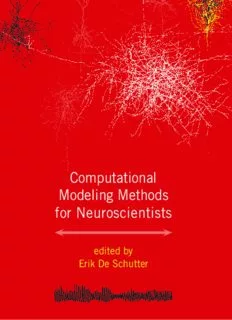Table Of ContentComputational
Modeling Methods
for Neuroscientists
edited by
Erik De Schutter
Computational Modeling Methods for Neuroscientists
Computational Neuroscience
Terence J. Sejnowski and Tomaso A. Poggio, editors
The ComputationalBrain, P.S. Churchland and T.J. Sejnowski, 1992
DynamicBiological Networks: The StomatogasticNervous System, R. M.Harris-
Warrick, E. Marder,A. I. Selverston, and M.Moulins, eds., 1992
The Neurobiology ofNeural Networks, D. Gardner,ed., 1993
Large-Scale NeuronalTheories of theBrain,C. Koch and J.L. Davis,eds., 1994
The TheoreticalFoundations of Dendritic Function: Selected Papers ofWilfrid Rall
withCommentaries,I. Segev, J.Rinzel,and G. M.Shepherd, eds., 1995
Models of Information Processing inthe Basal Ganglia,J. C. Houk, J. L.Davis,and
D. G. Beiser, eds., 1995
Spikes: Exploring the NeuralCode,F. Rieke, D. Warland, R. de Ruyter van
Steveninck,and W.Bialek, 1997
Neurons, Networks, and Motor Behavior,P. S. Stein, S. Grillner, A. I. Selverston,
andD. G. Stuart, eds., 1997
Methods in NeuronalModeling: From Ionsto Networks,secondedition, C. Koch
andI.Segev,eds., 1998
Fundamentalsof NeuralNetwork Modeling: NeuropsychologyandCognitive
Neuroscience, R. W.Parks, D. S. Levine, and D. L.Long, eds., 1998
Fast Oscillations inCortical Circuits,R. D. Traub, J. G. R. Je¤reys,and M.A.
Whittington, 1999
Computational Vision: Information Processing in Perception and Visual Behavior,
H. A. Mallot,2000
Neural Engineering:Computation, Representation,and DynamicsinNeurobiological
Systems,C. Eliasmithand C. H. Anderson, 2003
The ComputationalNeurobiology of Reaching and Pointing, R. Shadmehr and S.P.
Wise, eds., 2005
Dynamical Systems in Neuroscience, E.M.Izhikevich, 2006
Bayesian Brain: Probabilistic Approaches toNeuralCoding,K. Doya, S. Ishii, A.
Pouget, and R. P. N. Rao, eds., 2007
Computational ModelingMethods for Neuroscientists,E. De Schutter,ed., 2010
For a complete list of books in this series, seehttp://mitpress.mit.edu/
Computational_Neuroscience
Computational Modeling Methods for Neuroscientists
edited by Erik De Schutter
The MIT Press
Cambridge, Massachusetts
London,England
62010MassachusettsInstituteofTechnology
Allrightsreserved.Nopartofthisbookmaybereproducedinanyformbyanyelectronicormechanical
means (including photocopying, recording, or information storage and retrieval) without permission in
writingfromthepublisher.
Forinformationaboutspecialquantitydiscounts,pleaseemailspecial_sales@mitpress.mit.edu
ThisbookwassetinTimesNewRomanon3B2byAscoTypesetters,HongKong.
PrintedandboundintheUnitedStatesofAmerica.
LibraryofCongressCataloging-in-PublicationData
Computationalmodelingmethodsforneuroscientists/editedbyErikDeSchutter.
p. cm.—(Computationalneuroscienceseries)
Includesbibliographicalreferencesandindex.
ISBN978-0-262-01327-7(hardcover:alk.paper) 1.Computationalneuroscience. 2.Neurobiology—
Mathematicalmodels. I.DeSchutter,Erik. II.Series:Computationalneuroscience.
[DNLM: 1.Models,Neurological. 2.Neurosciences—methods.WL20C7382010]
QP357.5.C625 2010
612.8—dc22 2009006125
10 9 8 7 6 5 4 3 2 1
Contents
Series Foreword vii
Introduction ix
1 Di¤erential Equations 1
Bard Ermentroutand John Rinzel
2 Parameter Searching 31
PabloAchard, Werner Van Geit, and Gwendal LeMasson
3 Reaction-Di¤usion Modeling 61
UpinderS. Bhallaand Stefan Wils
4 ModelingIntracellularCalcium Dynamics 93
Erik De Schutter
5 ModelingVoltage-DependentChannels 107
Alain Destexhe and John R. Huguenard
6 ModelingSynapses 139
Arnd Roth and Mark C. W. van Rossum
7 ModelingPointNeurons: From Hodgkin-Huxley to Integrate-and-Fire 161
NicolasBrunel
8 Reconstructionof NeuronalMorphology 187
Gwen Jacobs, Brenda Claiborne,and Kristen Harris
9 AnApproach toCapturing Neuron Morphological Diversity 211
HaroonAnwar, Imad Riachi, Sean Hill, Felix Schu¨rmann,andHenry
Markram
10 Passive Cable Modeling 233
William R. Holmes
vi Contents
11 Modeling ComplexNeurons 259
Erik De Schutter and Werner VanGeit
12 Realistic Modeling of Small NeuronalNetworks 285
RonaldL. Calabrese and AstridA. Prinz
13 Large-Scale Network Simulations inSystems Neuroscience 317
Reinoud Maex, Michiel Berends, and Hugo Cornelis
Software Appendix 355
References 367
Contributors 405
Index 409
Series Foreword
Computational neuroscience is an approach to understanding the information con-
tent of neural signals by modeling the nervous system at many di¤erent structural
scales, including biophysical, circuit, and system levels. Computer simulations of
neurons and networks are complementary to traditional techniques in neuroscience.
Thisbookserieswelcomescontributionsthatlinktheoreticalstudieswithexperimen-
talapproachestounderstandinginformationprocessinginthenervoussystem.Areas
and topics of particular interest include biophysical mechanisms for computation in
neurons, computer simulations of neural circuits, models of learning, representation
of sensory information in neural networks, systems models of sensorimotor integra-
tion, and computational analysis of problems in biological sensing, motor control,
and perception.
Terrence J.Sejnowski
Tomaso Poggio
Introduction
I am writing this introduction a week after Wilfrid Rall received the inaugural
Swartz Prize for Theoretical and Computational Neuroscience. This event at the
2008 Society for Neuroscience meeting was a good demonstration of how much the
field of computational neuroscience has moved into the mainstream. Compare this
with the situation in 1989 when the first book in this MIT Press Computational
Neuroscienceserieswaspublished:MethodsinNeuronalModeling:FromSynapsesto
Networks,edited by ChristofKoch and Idan Segev.The first chapter ofthatseminal
book on methods explained what computational neuroscience was about. Less than
ten years later, in the second edition, such an introduction was no longer considered
necessary. The present book takes the next logical step and introduces modeling
methods to a broad range of neuroscientists.
The focus of this book is on data-driven modeling, i.e., the use of fairly standard-
ized modeling methods to replicate the behavior of neural systems at di¤erent levels
of detail. In general this will require numerical simulation of the model on a com-
puter. In this aspect the book clearly di¤ers from more theoretical approaches that
study how the brain computes and processes information. An excellent introduction
to that field is Theoretical Neuroscience by Peter Dayan and Larry F. Abbott, pub-
lished in the same MIT Press series. Together, this book and the Dayan and Abbott
one give a fairly complete overview of the current state of the field of computational
neuroscience. Both books assume a basic knowledge of neuroscience in order to un-
derstand the examples given and are therefore more suited for neuroscientists and
biologists than for scientists with a theoretical training entering the field. The latter
are advised to first study a basic neuroscience textbook. Scientists with a biological
or related background will also appreciate that this book tries to keep the required
mathematics at an introductory level and in addition starts with a chapter that
describes the necessary basic mathematical knowledge.
Data-driven modeling is a concept widely used in systems biology and covers the
numerical methods described in this book. The models are based on a limited set of
possibleequationsandthedi¤erencebetweenthemismainlyintheparametersused,
Description:This book offers an introduction to current methods in computational modeling in neuroscience. The book describes realistic modeling methods at levels of complexity ranging from molecular interactions to large neural networks. A "how to" book rather than an analytical account, it focuses on the pres

